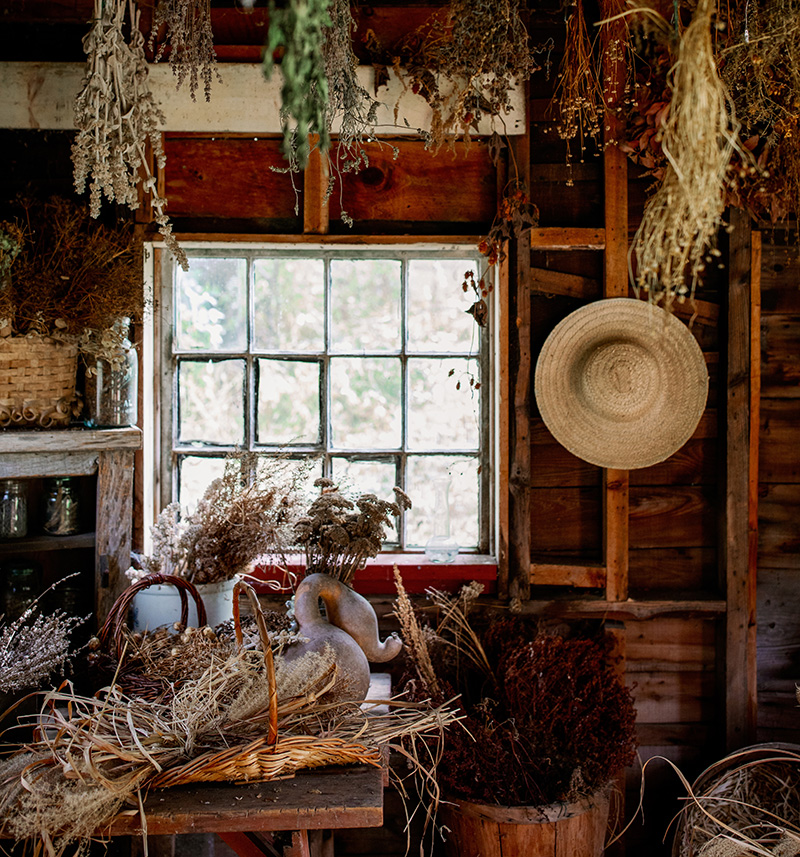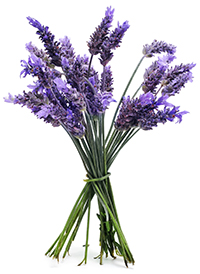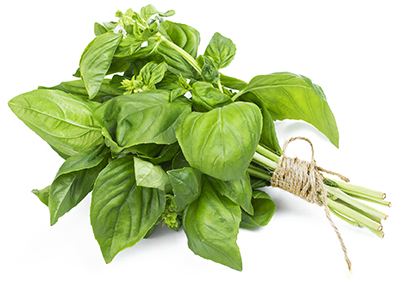

How to grow herbs indoors, plus what to do with your flavorful harvest.
We all have a few favorite herbs we can’t seem to cook without. If you enjoyed picking them fresh from your garden all summer, you don’t have to wait until spring to start growing them again. Head to your local garden center and see what they have for fresh herb plants, and check the seed racks while you’re there, too. Some fast-growing herbs—such as cilantro and basil—are easy to start from seed. Not sure what to grow? Think about what do you use the most; don’t waste precious windowsill space on something you won’t use.
The keys to success for your winter herb garden are light, light and light. Trying to grow summery plants indoors during the shortest days of the year can be challenging. The more bright sunlight the better—at least six hours per day. If you lack the proper orientation—south-facing windows are the best for most herbs— you may have to resort to grow lights.
Also, don’t overwater your herbs.
Wait until the top inch of the soil feels dry to the touch, then thoroughly water and let them drain so they are not sitting in a wet saucer. Herbs don’t like waterlogged soil, especially in winter when growth is slow.
If herbs are growing in a good, compost-based potting soil, the plants should not need any extra fertilizer. If you must fertilize, use a half-strength, liquid fertilizer meant for edible plants. Overfeeding your herbs will dilute their flavor.
Ten herbs for your windowsill garden
• Basil: Try a compact bush basil if space is tight; otherwise, plant several pots of a Genovese-type to spice up your Italian cuisine. The more you cut it, the more new growth you will see.
• Chives: Chives are a great cut-andcome-again crop even when grown in a pot. They are happy in an east or west window with less direct sun.
• Cilantro: If you can’t find a plant, it is easy enough to start from seeds. Just press them into the top of the soil and place the pot in a warm spot to germinate. Plant the seeds closely together, and later, thin to 3 inches apart. Be sure to eat the thinnings! Harvest frequently to prevent flowering. Cilantro is a short-lived plant, so after a few weeks start a new batch of seeds.
• Greek Oregano: There are many types of oregano, but look for authentic Greek oregano when plant shopping. It has the best flavor. Grow it in a hanging basket in the kitchen where can you cut it often.
• Lavender: Although lavender is not thought of as a traditional culinary herb, its scent will give you much pleasure during the winter. When used in cooking, a little goes a long way. Look for a tender, perennial variety, such as “Goodwin Creek” or Spanish lavender. These grow better on your windowsill than a hardy garden variety that may need a winter rest.
Move the plants outside in the summer to induce blossoming.
• Parsley: Since parsley is tap-rooted, it will appreciate a deep pot. Prolong the harvest by cutting sprigs from the outside of the plant, allowing the center to continue growing.
• Rosemary: This can be challenging to grow, needing a cool, bright spot with good air circulation. Mist the plant frequently, and water when the top inch of soil feels dry. Rosemary doesn’t like to have wet feet, so don’t let it sit in water.
• Sage: Common sage has the strongest flavor. Try a dwarf variety, if space is limited. If you want a fancy option, look for a tri-colored or golden variety—they have a milder flavor.
• Tarragon: This staple of French cuisine thrives in a north, east or west window. As long as tarragon gets between six and eight hours of bright light, it doesn’t need a lot of direct sun.
• Thyme: Aromatic English thyme or common garden thyme grow well in a pot or hanging basket. For extra flavor, try caraway, orange or lemon thyme, or slightly sweeter narrow-leaved French thyme.
Spice up your life Need ideas for what to do with your harvest? We asked a few local chefs to share their thoughts and recipes.
Pickity Place in Mason is known for its innovative, five-course menu that includes herbs and edible flowers grown onsite. They were serving farm-to-table meals long before that became the thing to do.
“There is a big difference between fresh herbs and dried, so it is best to use fresh whenever possible,” says chef Keith Grimes. He tries to incorporate them into every aspect of the meal—from appetizers and soups to main courses and desserts. Pickity Place even offers herbal drinks with their meals, including refreshing lavender lemonade. “Seeing lavender growing on your windowsill will give you hope for spring,” he says.
But asking him to choose his favorite herb is like asking him to pick his favorite child. “Chives are easy to grow, and they are a go-to herb that can be put into just about anything. But I really don’t have any favorites,” Grimes says. “My favorite is always whatever I am working on next.” However, he does admit to a preference for Mediterranean and Italian cuisines.
Liz Barbour, of the Creative Feast, is an author and cooking instructor from Hollis who presents online cooking demonstrations across New England. She also opens her edible garden for tours once a year. Knowing how hard it is to grow any quantity of usable herbs on a winter windowsill, she offers these suggestions: “Scallions are my number one favorite for a windowsill. You can buy them at the grocery store, cut and use the greens, and then put the white part—with roots attached—in a glass of water. The greens will regrow, and you can cut them again and again,” she says. “There’s no killing it! You don’t have to worry about watering them since they are growing in water.”
Rosemary topiaries are high on her list as well. “Once you find a spot with good air circulation and learn their watering needs, they are easy to grow,” Barbour says. If your windowsill garden is giving you a little of this and a little of that, she recommends making herb butter or herbes salée, a French-Canadian recipe made by layering fresh herbs with salt. “Both add a wonderful fresh flavor to everything you cook,” she says. Check out her book “Beautifully Delicious” for more ideas on using herbs and edible flowers.
Bruce Barnes and Jefferson Brechbuhl own and operate the Colby Hill Inn in Henniker. Their Grazing Room Restaurant is one of only three gold-level-certified farm-to-table restaurants in the state. Barnes and Brechbuhl not only source local ingredients from area farms, but also grow a lot of their own herbs and produce. Barnes, a prize-winning chef with a deep background in international cuisine, puts their work to good use. A few of his favorites are rosemary, thyme and sage. “Rosemary is excellent with meats and for hearty winter stews,” he says. “It is my go-to for braising with pork or beef.”

Since he likes the combination of citrus and thyme, one of his dishes features chicken, thyme and clementines slow-cooked in a Dutch oven. “I love sage with pork or turkey,” he says, “and I have my grandmother’s recipe for a simple brown butter sauce with sage that is delicious with potatoes, especially roasted fingerlings.”
Barnes says cilantro and garlic are universal herbs used in southeast Asian, Caribbean, Hispanic and Indian cooking. He makes a versatile chutney with them. If one of these cuisines is a favorite with your family, a pot or two of cilantro on the windowsill will be a good choice.
At the inn, Brechbuhl wears many hats, including bartender. He has fun creating cocktails using the herbs he grows in his extensive herb garden. “It only takes a few sprigs of mint, thyme, basil or lavender to turn an ordinary cocktail or martini into something truly special,” he says. Experiment with adding some of your windowsill herbs to a favorite beverage or follow one of his tried-and-true recipes. NHH
RECIPES WITH HERBS
Cilantro Chutney
Bruce Barnes says: “I like my chutney on the spicy side, and will often add 1 tablespoon of sambal oelek to the purée. I feel it gives it a bit more body and zing!”

1 cup of cilantro, washed, well drained and chopped
½ cup of parsley, washed, well drained and chopped
½ cup of grated, unsweetened coconut (optional)
1 1-inch clove of ginger, peeled and rough chopped
4 cloves of garlic, smashed and rough chopped
1 jalapeño, seeded and chopped
2 teaspoons of turmeric
1 teaspoon of cumin
1 teaspoon of garam masala
2 teaspoons of sugar
1 tablespoon of lemon juice Salt and pepper, to taste
¼ cup neutral oil, such as canola Ice water, as needed
1. In a food processor, layer tightly the cilantro, parsley, coconut, ginger, garlic and jalapeños. Pulse to coarsely grid the mixture. Sprinkle with the turmeric, cumin, garam masala and sugar. Pulse to blend in the dry ingredients. Add the lemon juice, and a pinch of salt and pepper.
2. Scrape the sides, turn on the processor and begin to drizzle in the oil. The chutney should begin to purée. Add the ice water to the chutney as needed to form a smooth, yet not watery purée. When done, the chutney should be smooth but rather thick. Adjust the salt to your liking.
Recipe courtesy of Bruce Barnes, Colby Hill Inn
Herbes Salées (Salted Preserved Herbs) MAKES ABOUT 1 CUP
Liz Barbour says: “This flavorful combination of fresh herbs can be used to season soups, sauces, stews, dressings, mashed potatoes, roasted vegetables and sautéed vegetables, and used to create flavorful butters. There is no one recipe for this wonderful condiment. I often choose a flavor profile for my herbes salées based on a dominant flavored herb that I have on hand and choose additional herbs that support that profile. Supportive herbs can be parsley, arugula, spinach, scallion and celery leaves. I prefer kosher salt, but you can choose any minimally processed coarse salt that you prefer. Because the herb salt is salty, use a little at first or 1:1 in recipes when replacing plain salt with your homemade herbes salées.
½ cup dill
1 cup flat leafed parsley
½ cup celery leaves
½ cup chives or scallions
½ cup mint, basil, or cilantro
¼ cup course mineral, Himalayan pink, kosher or other coarse salt
Note: The measurements above are for uncut leaves packed into a measuring cup. Herbes salées can keep for up to a year in the refrigerator. Divide the herb mixture into smaller jars if you prefer.
1. Roughly chop all your fresh herbs using a sharp knife. (If you prefer to use a food processor, pulse until the herbs are roughly chopped. The chopped herbs should remain bright green and loosely combined. Too much processing will turn the herbs into a bitter-tasting paste.) Combine the chopped herbs in a large bowl.
2. Layer 1 inch of herb mixture in the bottom of a 2-cup lidded jar, and sprinkle with some of the salt. Repeat in layers until all of the herb mixture and salt is used. Finish with 1 teaspoon of salt sprinkled on top. You will need to pack the herbs in tightly.
3. Cover and refrigerate for 2 weeks. After 2 weeks, open the jar and press the herbs firmly to release any extra water. Pour the water out. Refrigerate until ready to use.
Recipe courtesy of Liz Barbour, the Creative Feast
Herb combinations to try:
Single herbes salées: rosemary, thyme, basil, mint or celery salt are favorites of mine.
Mixed herbes salées
1 cup parsley, 1 cup sorrel, 1 cup celery leaf, 1 cup Egyptian onion or green onion, 1 cup lovage leaf 1½ cup parsley, 1½ cup leeks or onion, 1 cup shredded carrots, 1 cup finely chopped celery, ½ cup chives, ¼ cup tarragon, ¼ cup oregano, 3 tablespoons thyme, 2 tablespoons rosemary, 1 tablespoon sage
Stuffed Chicken Saltimbocca With Marsala, Basil and Sage
MAKES ABOUT 1 CUP
1 medium onion, diced
2½ ounces olive oil, divided
1 garlic clove, minced
¼ pound sliced prosciutto, diced
1 cup chicken stock
3 cups cubed basil or other herbed ciabatta bread
½ cup grated Parmesan cheese
½ cup shredded mozzarella
4 six-ounce boneless, skinless chicken breasts, pounded thin
4 slices provolone cheese
½ cup Italian breadcrumbs
1. In a medium-size sauce pan, sauté the onion in ½ ounce of the olive oil until the onions become opaque. Add the garlic, and cook for an additional minute. Add the prosciutto, and cook for 1 more minute. Add the chicken stock, and bring it to a boil. Remove the pan from heat, and let it cool. Add the ciabatta bread, Parmesan and mozzarella to the liquid. Combine to make the stuffing.
2. Preheat the oven to 350ºF. Lay the chicken, breast-skin side down, on a cutting board. Place one slice of provolone on each breast. Divide the stuffing onto each portion, and roll. Spray a sheet pan with nonstick food spray (or line it with parchment paper), and place the chicken on it. Sprinkle the breadcrumbs over the chicken, and drizzle with remaining 1 ounce of olive oil.
3. Cook for 35 minutes or until the chicken’s internal temperature reaches 165ºF. Let cool. Slice, top with Marsala basil sauce and serve.
Marsala Basil Sauce
1 cup Marsala wine
1 teaspoon fresh sage, chopped
1 tablespoon fresh basil, chopped
1/8 pound unsalted butter Salt and pepper, to taste
1. Add the Marsala wine, sage and basil to a sauté pan, and bring to a boil. When the bubbles of wine are large, reduce the heat. Add the cold butter, and swirl the pan until the sauce thickens.
2. When the wine sauce thickens, season with salt and pepper to taste and serve over sliced chicken.

Recipe courtesy of Keith Grimes, Pickity Place
RESOURCES
Colby Hill Inn and Grazing Room (603) 428-3281 • colbyhillinn.com
Creative Feast • (603) 321-5011 thecreativefeast.com
Pickity Place • (603) 878-1151 • pickityplace.com
Visit our sister publication at nhmagazine.com for more recipes.